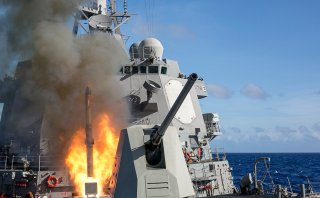From Land and Sea, the Navy's Smart Naval Strike Missile Is a Killer
The Naval Strike missile first emerged in 2012 and includes a 156-inch missile powered by a solid-propellant rocket motor booster and a turbo-jet engine fueled by JP-10 to enable subsonic speeds and sustained flight.
The Navy is fast-tracking multiple variants of its cutting-edge Naval Strike Missile engineered to fire both from land and the deck of a warship for long-range, precision attacks at targets beyond the radar horizon.
In a recent deal with Raytheon, the Navy is now surging production of a ground-based Naval Strike Missile Launcher Unit (NLU) and Weapon Control System (WCS).
The Naval Strike missile first emerged in 2012 and includes a 156-inch missile powered by a solid-propellant rocket motor booster and a turbo-jet engine fueled by JP-10 to enable subsonic speeds and sustained flight.
The land-fired NSM is called the Navy/Marine Corps Expeditionary Ship Interdiction System (NMESIS). “NMESIS is a land-based missile launcher platform that provides the Fleet Marine Force with an anti-ship capability. NMESIS integrates a NLU, capable of launching two NSMs [Naval Strike Missiles], onto a Remotely Operated Ground Unit for Expeditionary Fires carrier. The NLU is controlled by the WCS located externally in a command and control vehicle,” a Department of Defense announcement said.
While weapons themselves are rarely referred to as stealthy, the NSM is designed to have a lower radar signature by virtue of being able to attack while skimming close to the ocean’s surface, essentially below the aperture of many ship-based radars. The weapon also has a range of up to 100 nautical miles as well as advanced seeker technology, weapons developers explain.
“It climbs and descends with the terrain and performs evasive maneuvers to counter the world’s most capable defense systems. NSM possesses the capability to identify targets down to ship class — a feature that is vitally important to warfighters who must strike only specific, selected targets in congested, contested and denied environments,” a Raytheon paper from last year on the weapon said.
In terms of production, the Navy contract invests in domestic manufacturing facilities at Raytheon Missiles and Defense in Tucson, Arizona. This helps to ensure their capacity to meet demand from Navy, Marine Corps, and other customers. Because they’re buying the identical missile, using the same contract vehicle, the Navy and Marine Corps actually save money through reduced unit prices and logistics commonality.
Moreover, common logistics help support the Navy and Marine Corps’ multi-domain warfare strategy. For example, with proper networking, a land-based NSM could function as a critical defense “node” within a broader meshed system of sensors, meaning its targeting technology could find launching enemy weapons and pass the information to allied assets.
What is more likely, however, is that an island-based NSM might receive targeting specifics from an aerial drone, submarine, or ship-based radar system
Part of the NSM system can operate as a transportable and highly expeditionary, missile-armed, ground robot vehicle able to maneuver into attack positions from land and sea.
NSM is also built to transport on the Marine Corps’ emerging Light Amphibious Warship, a new platform intended to enable multi-domain, island hopping amphibious operations
Kris Osborn is the defense editor for the National Interest. Osborn previously served at the Pentagon as a Highly Qualified Expert with the Office of the Assistant Secretary of the Army—Acquisition, Logistics & Technology. Osborn has also worked as an anchor and on-air military specialist at national TV networks. He has appeared as a guest military expert on Fox News, MSNBC, The Military Channel, and The History Channel. He also has a Master's Degree in Comparative Literature from Columbia University.
Image: Flickr.

